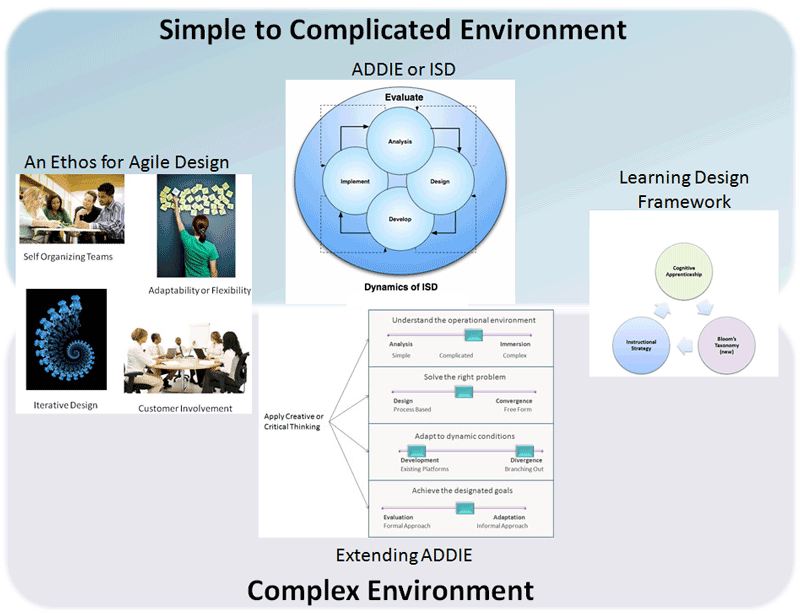Note: This site is moving to KnowledgeJump.com. Please reset your bookmark.
Visual, Auditory, and Kinesthetic Learning Styles (VAK)
The VAK learning style uses the three main sensory receivers: Visual, Auditory, and Kinesthetic (movement) to determine the dominant learning style. It is sometimes known as VAKT (Visual, Auditory, Kinesthetic, & Tactile). It is based on modalities—channels by which human expression can take place and is composed of a combination of perception and memory.
VAK is derived from the accelerated learning world and seems to be about the most popular model nowadays due to its simplicity. While the research has shown a connection with modalities and learning styles (University of Pennsylvania, 2009), the research has so far been unable to prove the using one's learning style provides the best means for learning a task or subject. This is probably because it is more of a preference, rather than a style.

Learners use all three modalities to receive and learn new information and experiences. However, according to the VAK or modality theory, one or two of these receiving styles is normally dominant. This dominant style defines the best way for a person to learn new information by filtering what is to be learned. This style may not always to be the same for some tasks. The learner may prefer one style of learning for one task, and a combination of others for a different task.
Classically, our learning style is forced upon us through life like this: In grades kindergarten to third, new information is presented to us kinesthetically; grades 4 to 8 are visually presented; while grades 9 to college and on into the business environment, information is presented to us mostly through auditory means, such as lectures.
According to the VAK theorists, we need to present information using all three styles. This allows all learners the opportunity to become involved, no matter what their preferred style may be.
While there is some evidence for modality specific strengths and weaknesses (Rourke, et al. 2002), what has has not been established is matching the instructional style to individual learning strength improves their learning abilities. For example, one study (Constantinidou and Baker, 2002), found that visual presentation through the use of pictures was advantageous for all adults, irrespective of a high or low learning-style preference for visual images. Indeed, it was especially advantageous for those with a strong preference for verbal processing.
Hints for Recognizing and Implementing the Three VAK Styles
Auditory learners often talk to themselves. They also may move their lips and read out loud. They may have difficulty with reading and writing tasks. They often do better talking to a colleague or a tape recorder and hearing what was said. To integrate this style into the learning environment:
- Begin new material with a brief explanation of what is coming. Conclude with a summary of what has been covered. This is the old adage of “tell them what they are going to lean, teach them, and tell them what they have learned.”
- Use the Socratic method of lecturing by questioning learners to draw as much information from them as possible and then fill in the gaps with you own expertise.
- Include auditory activities, such as brainstorming, buzz groups, or Jeopardy. Leave plenty of time to debrief activities. This allows them to make connections of what they leaned and how it applies to their situation.
- Have the learners verbalize the questions.
- Develop an internal dialogue between yourself and the learners.
Visual learners have two sub-channels—linguistic and spatial. Learners who are visual-linguistic like to learn through written language, such as reading and writing tasks. They remember what has been written down, even if they do not read it more than once. They like to write down directions and pay better attention to lectures if they watch them. Learners who are visual-spatial usually have difficulty with the written language and do better with charts, demonstrations, videos, and other visual materials. They easily visualize faces and places by using their imagination and seldom get lost in new surroundings. To integrate this style into the learning environment:
- Use graphs, charts, illustrations, or other visual aids.
- Include outlines, concept maps, agendas, handouts, etc. for reading and taking notes.
- Include plenty of content in handouts to reread after the learning session.
- Leave white space in handouts for note-taking.
- Invite questions to help them stay alert in auditory environments.
- Post flip charts to show what will come and what has been presented.
- Emphasize key points to cue when to takes notes.
- Eliminate potential distractions.
- Supplement textual information with illustrations whenever possible.
- Have them draw pictures in the margins.
- Have the learners envision the topic or have them act out the subject matter.
Kinesthetic learners do best while touching and moving. It also has two sub-channels: kinesthetic (movement) and tactile (touch). They tend to lose concentration if there is little or no external stimulation or movement. When listening to lectures they may want to take notes for the sake of moving their hands. When reading, they like to scan the material first, and then focus in on the details (get the big picture first). They typically use color high lighters and take notes by drawing pictures, diagrams, or doodling. To integrate this style into the learning environment:
- Use activities that get the learners up and moving.
- Play music, when appropriate, during activities.
- Use colored markers to emphasize key points on flip charts or white boards.
- Give frequent stretch breaks (brain breaks).
- Provide toys such as Koosh balls and Play-Dough to give them something to do with their hands.
- To highlight a point, provide gum, candy, scents, etc. which provides a cross link of scent (aroma) to the topic at hand (scent can be a powerful cue).
- Provide high lighters, colored pens and/or pencils.
- Guide learners through a visualization of complex tasks.
- Have them transfer information from the text to another medium such as a keyboard or a tablet.
VAK Survey
Free VAK Survey.
References
Constantinidou, F. and Baker, S. (2002). Stimulus modality and verbal learning performance in normal aging. Brain and Language, 82(3), 296–311.
Rourke, B., Ahmad S., Collins, D., Hayman-Abello, B., Hayman-Abello, S., and Warriner, E. (2002). Child clinical/pediatric neuropsychology: some recent advances. Annual Review of Psychology, 53, 309Ð339.
University of Pennsylvania (2009). Visual Learners Convert Words To Pictures In The Brain And Vice Versa, Says Psychology Study. ScienceDaily. Retrieved July 10, 2011, from http://www.sciencedaily.com/releases/2009/03/090325091834.htm



